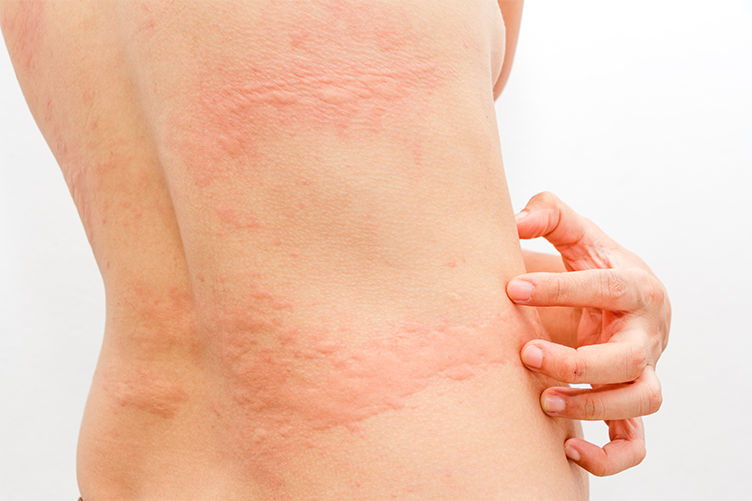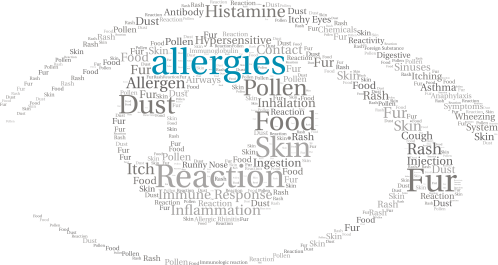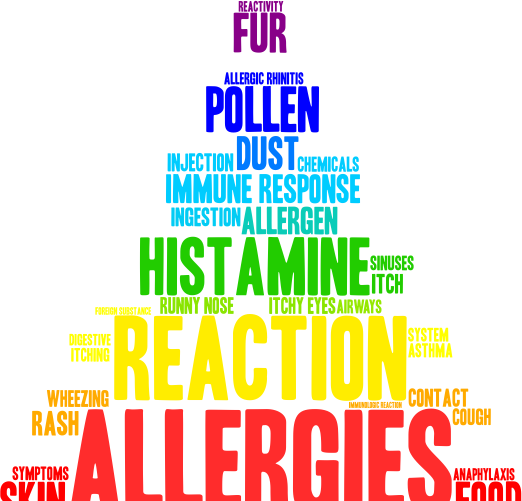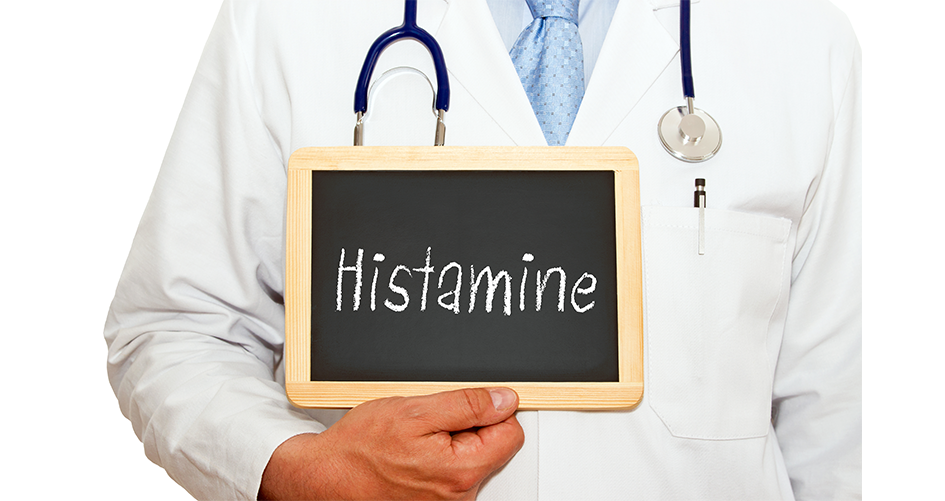Allergy or Histamine Intolerance?
What is Histamine?
Histamine is a chemical produced by cells of the body, which the body then stores.
It is released by these cells, called “mast cells”, in response to injury, and in an allergic or inflammatory reaction, as part of our immune response, and causes contraction of smooth muscle, stimulation of gastric acid secretion and dilation of capillaries.
In other words, Histamine is a chemical substance in the body that causes the symptoms that people experience when they are allergic to something.
It causes the allergic reaction, or a histamine reaction. [1]

We need a certain amount of histamine to live and function, but too much of it can cause painful symptoms involving the skin, the brain, lungs and heart and digestive system.
So when you come across your allergy trigger or you suffer an injury, however small, your immune system immediately starts a chain reaction to defend you.
First, it sends a chemical signal to “mast cells” in all the vital organs, ie. the skin, nose, lungs, blood, gut and mouth, instructing them to release histamine.
Then the histamine reaction starts.
Since it is a neurotransmitter, histamine sends signals to the brain to make blood vessels dilate.
This boosts blood flow and causes inflammation, so that white blood cells and other chemicals from the immune system can reach the site of the problem quickly and start repairing it.
The histamine build-up at the site of the problem may cause headaches, itching, flushing and irritability.
This is part of the body’s natural immune response.[2] [3]
However, some people cannot break down histamine properly, and may develop what is known as histamine intolerance.
What Causes Histamine Intolerance?
As well as being produced by cells of the body, histamine can be ingested through food.
Histamine intolerance is an intolerance of histamine taken in with food.

Everyone has a different “normal” histamine level, that is, one their body can tolerate without symptoms.
This level is usually determined by genetics, and can be lowered by hormonal changes, as in menstruation and menopause, and by medications.
Some say histamine intolerance is an acquired condition, secondary to some underlying condition.
People with a low tolerance threshold are designated histamine intolerant.
These people, when they consume a large amount of histamine foods, will experience an adverse reaction, known as a histamine reaction, such as headaches, flushing and itching.

Normally, histamine is broken down in the body by two different enzymes.
When histamine levels exceed a certain limit, these enzymes come into action and break it down.
If one of these enzyme systems becomes deficient, the rate of breakdown of excess histamine is insufficient to deal with the excess, the total level of histamine in the body rises.
At a certain critical level, signs and symptoms occur that often indistinguishable from allergy.
Histamine Intolerance Symptoms
These are similar to histamine allergy symptoms, and include:
- Headaches/migraines
- Difficulty falling asleep
- Hypertension/Hypotension
- Vertigo or dizziness
- Arrhythmia, or accelerated heart rate
- Difficulty regulating body temperature
- Anxiety
- Nausea, vomiting
- Pruritus (itching especially of the skin, eyes, ears, and nose)
- Urticaria (hives)
- Tissue swelling, especially of facial and oral tissues and sometimes the throat.
- Chest pain
- Nasal congestion and runny nose
- Conjunctivitis
- Fatigue, confusion, irritability
- Heartburn/ Acid Reflux [4]
Histamine Foods
Some foods are notoriously high histamine foods, such as the following:
- Alcohol
- Vinegar and pickled foods
- Smoked meats
- Canned foods
- Mature cheeses
- Shellfish
- Beans and pulses – chickpeas, soy beans, peanuts
- Nuts – walnuts, cashew nuts
- Chocolate/cocoa
- Ready meals
- Salty snacks, sweets with preservatives and artificial colourings
This list of foods is sometimes referred to as the histamine intolerant food list, and should be avoided by those with histamine intolerance.
Whilst there is no such thing as an anti-histamine diet, or a histamine-free diet, there are some foods that are low in histamines:
- Fresh meat
- Freshly caught fish
- Fresh chicken
- Egg yolk
- Fresh fruits – with the exception of strawberries
- Fresh vegetables – with the exception of tomatoes
- Grains
- Fresh pasteurised milk and milk products
- Milk substitutes – coconut milk, rice milk
- Cream cheese, butter
- Most cooking oils
- Most non-citric fruit juices
As a general rule, those trying to follow a histamine intolerance diet should opt for the above foods, buy only fresh food, do not leave foods out of the refrigerator, cook it yourself, and be hygienic in the kitchen. [5]
Histamine Intolerance Treatment
First, one needs to rule out the possibility that symptoms are caused by an allergy to a specific food.
Then, high histamine foods should be avoided for about a month, before being gradually reintroduced to see how much can be tolerated.
This level should be noted and not exceeded.
A balanced diet should be maintained at all times, concentrating mainly on low histamine foods from the list above, so the help of a dietician may be helpful here. [6]
Additionally, histamine intolerant supplements can be taken, to help keep histamine in check and mast cells stable.
Here are a few recommended supplements:
- Querticin+C – this is a mast cell stabilizer (6a)
- Albizia lebbeck, stem bark dry (Albizia) may relieve symptoms of allergies and hay fever by stabilising mast cells.
- Probiotics – these help heal the gut and prevent further allergies from developing
- Nigella Black Seed Oil – this is an anti-histamine that acts on the respiratory and digestive systems (6b)
- Vitamins D3, B6 and C – scientific researchers recommend that patients should take these supplements as they support the breakdown of histamines. [7] [8] [9]
Histamine intolerance is an inconvenient condition but with proper care it can be managed to give patients a normal life.
1] britannica.com/science/histamine
2] mindbodygreen.com/0-11175/everything-you-need-to-know-about-histamine-intolerance.html
3] webmd.com/allergies/what-are-histamines#1
4] foodsmatter.com/allergy_intolerance/histamine/articles/histamine_joneja.html
5] histamineintolerance.org.uk/about/
6] allergyuk.org/common-food-intolerances/histamine-intolerance
6a] ncbi.nlm.nih.gov/pubmed/22470478
6b] sciencedirect.com/science/article/pii/S1319562X14001302
7] healinghistamine.com/histamine-intolerance-supplements/
8] dietvsdisease.org/histamine-intolerance/
9] .foodsmatter.com/allergy_intolerance/histamine/articles/q&a-joneja.html

MORE BLOG STORIES
Breaking Down the B Vitamins
Amazing Ways to Help Heal Mitochondrial Dysfunction!
The 5 Worst Foods For Your Gut
‘THE GOLDEN GODDESS’
Mitochondria, Inflammation and Oxidative Stress
Tired? You May Be Suffering From Mitochondrial Dysfunction